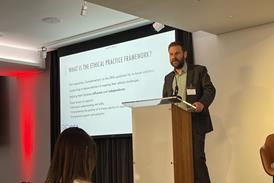Hackathons signal a new direction for legal IT – buying into the startup culture.
Law firms are becoming data-driven, deploying business intelligence tools and employing business analysts. At the same time, the new legal services buzzwords are ‘agility’ and ‘innovation’.
However, not all industry players are walking the talk. Some UK and US law firms responded quite negatively to end-of-life announcements for legacy software by Microsoft and Thomson Reuters. This highlights the dichotomy between the traditionally risk-averse, change-averse law firm culture and the exciting climate of innovation that is transforming the sector. Firms that are harnessing the dynamism of the start-up economy are leveraging the differences and changing the direction of legal IT.
At the Guardian’s Changing Media summit, advertising industry veteran Sir John Hegarty made the controversial comment that advertising’s focus on data analytics (looking at audience behaviours and preferences in order to determine the best time to air particular adverts, identify target demographics and develop brands) are stifling creativity and innovation. He suggested that big data leads entire industries to the same conclusions and brainstorming never produces genius.
Sir Martin Sorrell disagreed – because all businesses need to adapt to the digital world. He added, however, that the advertising industry needed a rebrand because the availability and impact of data represent a profound change to the way that creativity is born. ‘You don’t see too many examples of data-informed creativity,’ he said.
Sorrell’s comment could equally be applied to legal services. Data is important, but so are innovation and agility which are borne out of creative and design-led thinking – doing things differently and responding rapidly to dynamic market forces.
Avoiding analysis paralysis
Corporate legal departments require data as part of e-procurement and use business intelligence tools to facilitate e-billing and monitor matters in real time. Nonetheless, it is important to avoid analysis paralysis, whereby data-driven organisations are in danger of stifling their creativity.
Martyn Wells, IT director at Wright Hassall featured in C24’s recent case study about transforming law firms into data-driven organisations. Wells was an early adopter of big data analytics, initially using C24’s Bi24 business intelligence (BI) platform, which includes data visualisation, to support the firm’s debt recovery business. A geo-demographic heat map identifies which locations have a higher propensity to pay and the team concentrates its efforts on these areas, significantly improving its success rates. Data analysis supports decisions on how to proceed with each case.
More recently, Wells has applied similar techniques to key industry areas where the firm is looking to expand. The AI element of the BI platform means that natural language is used to identify clusters of data – for example, how many conveyancing instructions the firm is handling – and then drill down into the detail, to split the data by location, property type, price and so on. Client dashboards give clients real-time access to work in progress (WIP). On the firm side, data analytics applied to internal processes prevents the build-up of WIP and lock-in, and supports work allocation and team management.
Wells’ solution to the analysis paralysis trap is to apply big data principles and analysis to specific business and practice areas – avoiding ‘scope creep’ by working within parameters, milestones and desired outcomes. On the tech side it’s about designing a UX (user experience) with built-in flexibility so that users can shift seamlessly between applications. He highlights an additional benefit in terms of creativity. Wright Hassall is expanding and deploying cutting-edge technology such as big data, and AI helps to attract tech-savvy digital natives.
‘Nano-agile’ creativity
Hegarty suggested that big data cannot be a differentiator because it gives everyone the same insights. Does this mean that process management limits creativity?
In terms of technology, it seems not. Law for Good, Europe’s first law tech hackathon, was organised by Legal Geek’s Jimmy Vestbirk to find solutions for Hackney Community Legal Centre which provides free legal advice. It was won by Fresh Innovate, a team from Freshfields Bruckhaus Deringer, one of just a few major law firms that participated. They created a comprehensive portal management system that was coded and built overnight and included an interactive website. In joint-second place was an AI-powered SMS virtual receptionist (which also linked to an existing online translation engine) and an SMS appointment reminder service.
Enterprise architect Milos Kresojevic, who led Freshfields’ team, explained how the winning solution combined inspiration and discipline to keep the energy and enthusiasm up all weekend. ‘We worked in a way that we call ‘“nano-agile’,” he said. ‘It’s about delivering one functionality every three hours. We decided on the functionalities and the order of delivery at the start and every 20 minutes we had a five-minute stand-up meeting to discuss any issues or challenges. It’s about keeping delivery on track throughout the hackathon.’
Hackathons are signalling a new direction for legal IT, bringing in the start-up attitude and culture. ‘The hackathon brought together a mix of lawyers and technologists working together in teams,’ says Kresojevic, who works in Freshfields’ legal innovation team. ‘This is a potential model for the future delivery of legal services, not just for start-ups, but for larger firms too as it leverages different skills to create tangible value.’
Kresojevic believes that big data analytics, rather than stifling innovation, could uncover opportunities for law firms – the scale of the data and the amount of information analysed increase the scope for developing new products and services.
Agility challenge
The agility challenge for law firms is cultural: to involve lawyers, who are intrinsically risk-averse and resistant to change, in finding new and different ways of working. For legal IT, it is about combining innovation with resilience, accessibility and information security.
Doing things differently underpins DWF’s strategy. Rather than expecting the IT director and his department to keep the lights on, innovate and evangelise, it is addressing the cultural challenge by splitting its technology function into three divisions: IT services that manage the business-critical IT that all firms require (such as document management and practice management); a business services team that liaises with lawyers and clients to ensure that technology genuinely supports and enhances service delivery (this team is not part of the IT department); and a wholly owned start-up, 15squared, which was set up in 2015 to develop bespoke IT solutions for the firm’s clients.
Whispering not evangelising
DWF’s development director Jonathan Patterson heads a business services team that does what he describes as ‘lawyer whispering’ – liaising with lawyers across the firm to establish their business needs in terms of technology and working with IT to deliver or develop the appropriate solution.
Patterson’s team, which is not part of the IT department ‘brings law’s two worlds together’ focusing on innovation, efficiency and future-oriented solutions. He believes that engagement is fundamental to the success of law firm technology projects, many of which fail because of culture clash: lawyers feel that IT is selling them change in the form of a new tool or way of working. Patterson works closely with fee-earners to identify meaningful problems that can be resolved with technology, and opportunities to improve client services.
DWF has shifted the traditional focus of legal IT, whereby the IT department handles everything from developing, selecting or outsourcing applications and systems to liaising with lawyers – Patterson’s team has a specific remit to ‘translate’ fee-earners’ needs into practical IT solutions.
Thomson Reuters’ recent Knowledge Management Forum strapline was ‘adapting to a new era’. It included a session where Oz Benamram, chief knowledge officer at White & Case and Eric Hunter, director of knowledge, technology and innovation strategies at Bradford & Barthel, discussed the application of big data and AI to the legal knowledge function.
Benamram read out a list of technologies – some mainstream legal IT and some cutting-edge – and asked for a show of hands to indicate which firms and legal departments had implemented them, were considering this, or had never heard of them. Responses suggested that while there is a lot of talk about technology and change, not many firms are stepping out of the mainstream.
When it came to AI, for example, although everyone had heard something about it and some were considering it, only a small minority of attendees (mostly from top 100 UK and US firms and heads of legal knowledge at global organisations) were implementing sophisticated AI tools, although the majority were using some form of document automation, such as Contract Express.
Lawyer-led innovation
This is not to say AI is not encroaching into legal. The combination of AI and cloud services has driven another significant shift in law firm thinking about technology: technology innovation can happen in a law firm without necessarily being led by the IT director or deploying IT resources (or budget), although obviously the IT and risk functions would need to be consulted/involved.
At ILTA’s London Roadshow Wendy Miller, joint head of real estate disputes at Berwin Leighton Paisner (BLP) and by her own admission not a technologist, explained how BLP’s contract robot powered by RAVN’s Applied Cognitive Engine has transformed processes within the real estate disputes team. The project was initiated by the practice and not by BLP’s IT department, and as it was a cloud-hosted solution, implementation was lawyer-led with minimum input from IT.
Another memorable moment from the ILTA event was when legal IT consultant Neil Cameron asked everyone with an iPhone to give Siri the famous command that Dave Bowman gave HAL 9000 in the film 2001: A Space Odyssey - ‘Open the pod bay doors’. We all got different answers. Mine was, ‘Joanna, can’t you slide it under the door?’ I guess the iPhone’s location services had established that I was not in outer space so based on its contextual data Siri suggested a different approach.
The new direction in legal IT at the moment is a recognition that business agility in the form of doing things differently does not necessarily require a wholesale change in law firm culture. It can also mean buying in some start-up culture.
At DWF, Patterson observes that law firms that are genuinely forward-thinking in terms of technology are investing in start-ups because they recognise that the law firm culture is not necessarily conducive to innovators/innovation, so they need to find another way to harness entrepreneurial creativity.































No comments yet